Cashmere scarves are luxury accessories known for their exceptional warmth, softness, and durability. The cashmere wool used to make these scarves comes from the undercoat of the Cashmere goat, which is native to the cold, mountainous regions of Mongolia, China, and some other countries in Central Asia.
Cashmere is renowned for its superior insulating properties and lightweight nature, which make it ideal for a wide range of garments, including scarves. A well-made cashmere scarf provides warmth without bulk and can be used in both casual and formal settings due to its elegant appearance and rich texture.
These scarves come in a variety of styles, colors, and patterns, making them versatile accessories that can be paired with different outfits. Whether for men or women, a cashmere scarf is often seen as a timeless piece, adding a touch of sophistication and luxury to any look.
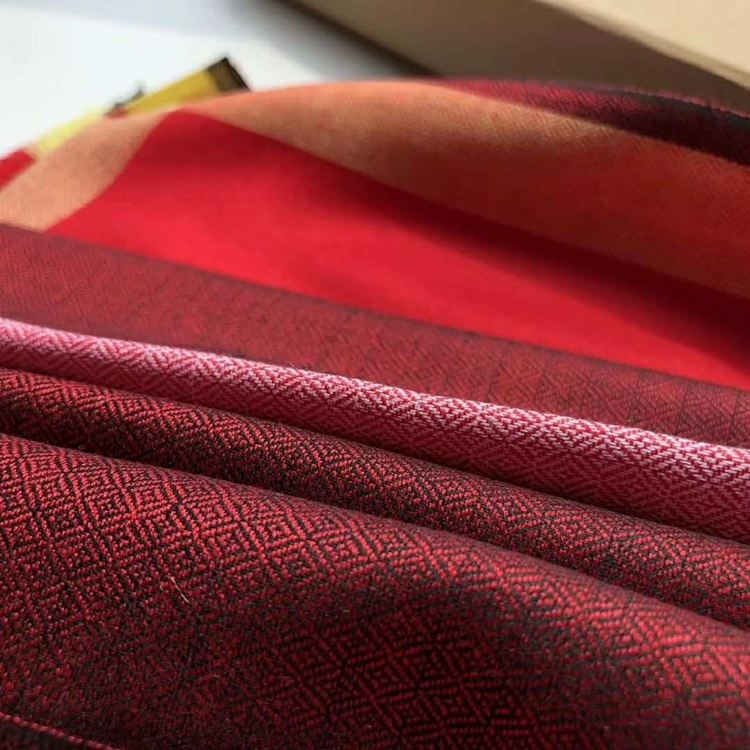
Buying a cashmere scarf is an investment due to its higher cost compared to scarves made from other materials, but its longevity and timeless appeal often make it a worthwhile purchase. It’s important to take proper care of a cashmere scarf by following suitable washing, drying, and storage practices to maintain its quality over time.
From an ethical perspective, it’s also worth noting the environmental impact of cashmere production and the efforts made by some brands to produce sustainable and ethically sourced cashmere products. These factors may also influence the decision of consumers when purchasing a cashmere scarf.
How Cashmere Scarves are Made
The production of cashmere scarves is a multi-step process that starts with the procurement of raw cashmere and ends with a beautifully crafted product. This involves both manual labor and mechanized processes, each requiring a high level of precision and expertise.
The Process of Producing Cashmere Wool
- Collection: Cashmere is derived from the undercoat of Cashmere goats, which are predominantly found in the high-altitude regions of Mongolia, China, India, and Iran. The wool is collected during the spring moulting season when the goats naturally shed their winter coat. The fibers are either combed out by hand or gathered from the fields where these animals graze.
- Sorting: The collected raw cashmere then undergoes a sorting process, also known as ‘de-hairing’. This is done to separate the fine, soft undercoat (the actual cashmere) from the coarse, outer guard hairs. Advanced machinery is often used for this process, but manual sorting can sometimes provide better results, ensuring up to 97% purity.
- Cleaning: Post sorting, the cashmere is cleaned to remove impurities such as dirt, grease, and sweat. This requires washing the fibers in a mild alkaline solution.
- Dyeing: Once cleaned, the fibers can be dyed. Unlike synthetic fibers, cashmere takes on dyes extremely well, offering a rich, vibrant color that enhances its natural beauty.
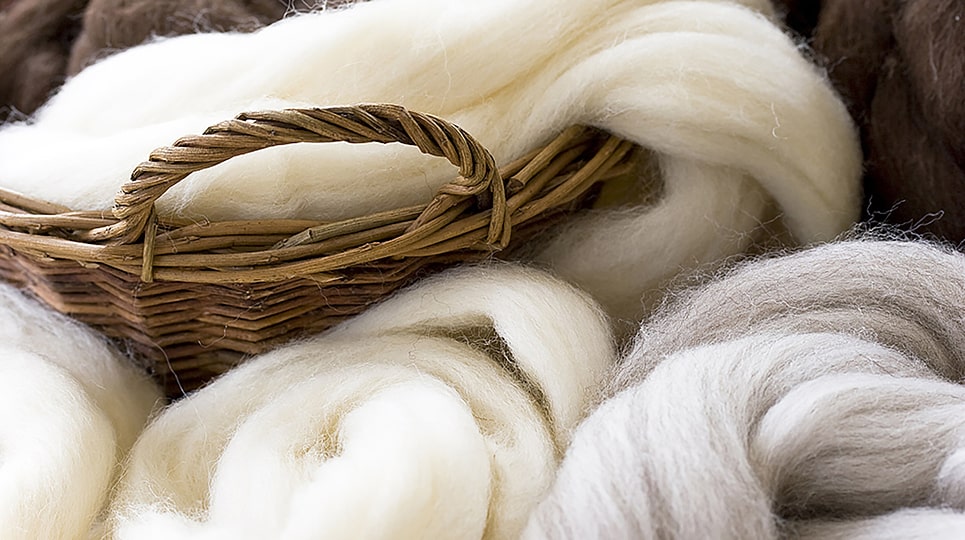
Weaving Cashmere into Scarves
- Spinning: The cleaned and dyed cashmere is then spun into yarn. This process involves drawing out the fibers and twisting them together to create a long, continuous thread. This can be done either by hand or using spinning machinery.
- Weaving/Knitting: The spun cashmere yarn is then woven or knitted into scarves. This can be done on a handloom for a more artisanal approach, or on a machine for mass production. The latter approach is more efficient but may compromise the individuality and quality of the end product.
Quality Indicators for Cashmere Scarves
Several indicators help ascertain the quality of cashmere scarves. These include:
- Fiber Length: High-quality cashmere generally has a longer fiber length, usually above 34-36mm. Longer fibers increase the durability of the scarf and reduce pilling.
- Fiber Diameter: The fineness of the fiber is crucial. Finer fibers (between 14-18.5 microns in diameter) result in a softer and smoother scarf.
- Ply: The ply of the scarf (the number of strands twisted together to make the yarn) can influence its warmth, weight, and durability. A 2-ply scarf is generally warmer and less prone to holes than a 1-ply scarf.
- Tightness of Weave/Knit: A tighter weave or knit usually indicates a higher-quality scarf as it holds its shape better and is more resistant to stretching and sagging.
- Hand Feel: High-quality cashmere should feel soft and luxurious to the touch. Any roughness or itchiness may indicate a lower quality product.
- Finish: The finishing touches such as the neatness of edges and the quality of any additional embellishments also indicate the overall quality of the scarf.
By understanding these processes and quality indicators, consumers can make more informed decisions when purchasing cashmere scarves, ensuring they invest in a product that truly delivers on the promise of cashmere’s natural luxury and durability.
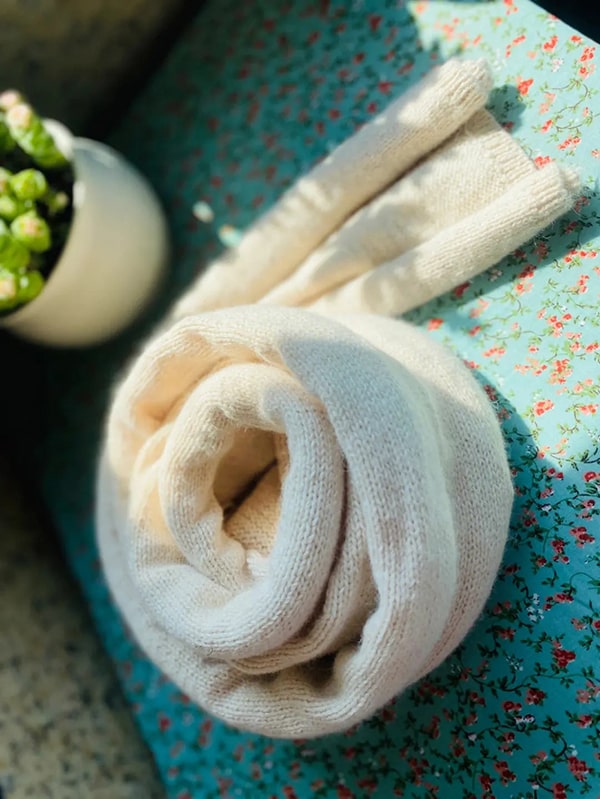
Cashmere Scarves for Women
The versatility, softness, and luxurious nature of cashmere scarves make them a coveted accessory among women. Here’s a data-driven and professional analysis of the styles, trends, outfit pairings, and considerations for choosing the right scarf.
Popular Styles and Trends
- Oversized Cashmere Scarves: As per the fashion trend reports of 2023, oversized cashmere scarves are increasingly popular among women. These large scarves offer ample warmth and can be styled in various ways, making them a versatile addition to any wardrobe.
- Infinity Cashmere Scarves: Infinity scarves, essentially a loop of fabric with no ends, continue to be a trend due to their easy-to-wear nature. They are perfect for a chic, effortless look.
- Cashmere Pashminas: A timeless classic, pashminas, are renowned for their sheer elegance. These are typically wider and longer than standard scarves, often embellished with fringes or tassels at the ends.
- Patterned Cashmere Scarves: While solid colors are perennial favorites, scarves with patterns such as plaids, checks, and animal prints are gaining popularity for their ability to add a pop of interest to outfits.
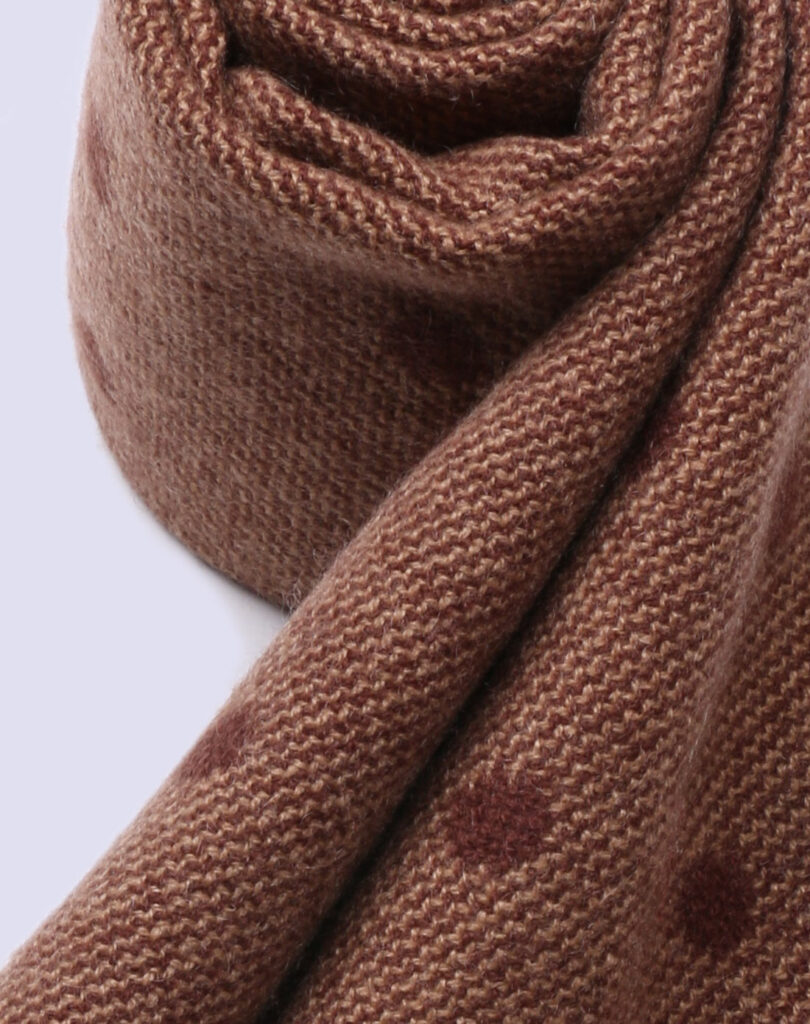
Outfit Pairings and Styling Tips
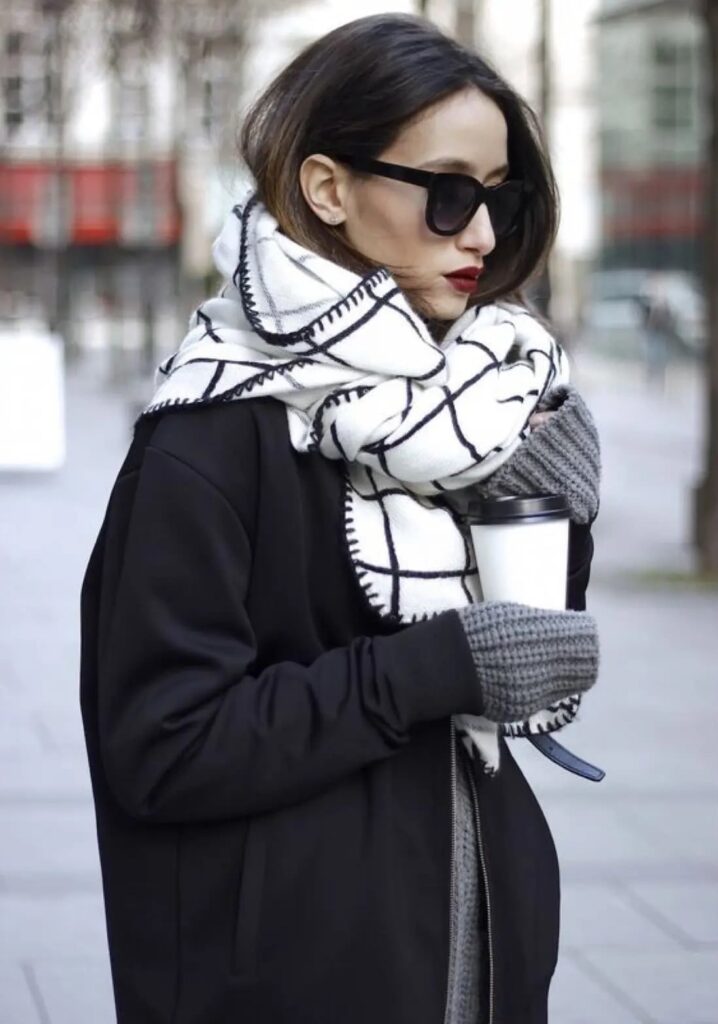
Going for a relaxed and casual look doesn’t require a complex ensemble. A simple white tee and jeans can be elevated by adding a brightly colored cashmere scarf. This should be wrapped loosely around the neck, letting it hang down for an easy and effortless style.
On other days, consider pairing a white scarf with a black coat. The contrast of the colors offers a chic look, while the choice of a more subdued scarf color ensures it complements your outfit nicely. Whether you opt for a neat knot or a simple drape over your shoulder, it works well with your stylish coat and other professional attire.
As you’re preparing for an evening out, don’t forget the possibility of adding a touch of elegance with a cashmere pashmina. An embellished one in a deep, rich shade can truly enhance your look. Draping it over your shoulders as a wrap pairs beautifully with a formal dress, resulting in an elegant and sophisticated outfit for the night.
Choosing the Right Scarf for Different Occasions
- Daily Wear: For everyday wear, consider a durable, mid-weight cashmere scarf in a color that complements most of your wardrobe. A versatile color like grey, navy, or beige is a safe choice.
- Outdoor Activities: If you’re participating in outdoor winter activities, an oversized cashmere scarf or snood would provide ample warmth and comfort.
- Formal Events: For formal events, opt for a fine, lightweight cashmere pashmina in a luxe color or with delicate embellishments.
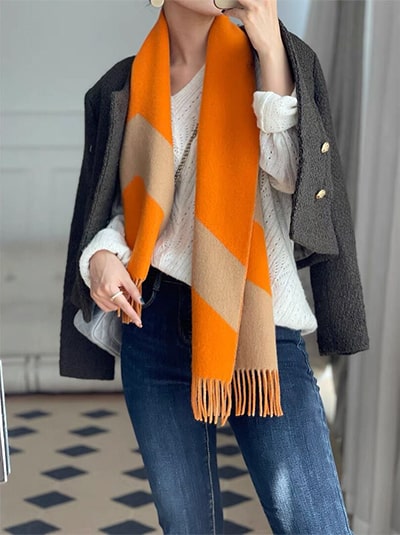
When choosing a cashmere scarf, it’s not only about the style and color but also about the quality of the cashmere. An authentic, high-quality cashmere scarf, while being an investment, will offer superior warmth, longevity, and timeless elegance.
Cashmere Scarves for Men
Cashmere scarves are a popular accessory for men due to their combination of practicality, comfort, and style.
Here’s a data-driven and professional overview of popular styles, styling tips, and choosing the right scarf for different occasions.
Popular Styles and Trends
- Traditional Cashmere Scarves: The traditional, long rectangular scarf is a staple for men, offering great versatility in terms of styling. They’re typically in more subdued or neutral colors and classic patterns like tartan and herringbone.
- Infinity Cashmere Scarves: Infinity scarves are becoming increasingly popular among men for their simplicity and modern appeal. They are easy to wear, removing the need for complicated knotting or draping.
- Oversized Cashmere Scarves: A trend borrowed from women’s fashion, oversized cashmere scarves are gaining popularity among men. They offer increased warmth and a bold fashion statement.
How to Style a Cashmere Scarf
- The Drape: This is the simplest way to wear a scarf – just drape it over your neck, letting both ends hang down evenly. This style works best with a suit or a formal coat.
- The Once-Around: Drape the scarf around your neck, then wrap one end around your neck once. This provides a bit more warmth and is a more casual style, suitable for a jacket or a winter coat.
- The Parisian Knot: This is a stylish yet practical way to tie a scarf. Fold the scarf in half lengthwise and drape it around your neck. Pull the loose ends through the loop created by the fold. This knot is best for cold weather and can be worn with casual or formal outerwear.
Choosing the Right Scarf for Different Occasions
- Work/Professional Settings: For a professional setting, opt for a high-quality, traditional cashmere scarf in a neutral color like black, gray, or navy. This can be paired with a winter coat or a suit.
- Casual Outings: For more casual occasions, you might consider a patterned or brightly colored cashmere scarf to add a touch of personality to your outfit. This can be paired with a winter jacket or a casual coat.
- Outdoor Activities: If you’re going to be spending a lot of time outdoors, consider an oversized cashmere scarf or an infinity scarf for maximum warmth and comfort.
Quality is paramount when choosing men’s cashmere scarves. While authentic cashmere may come at a higher price point, its longevity, warmth, and timeless appeal make it a worthwhile investment.
Caring for Your Cashmere Scarf
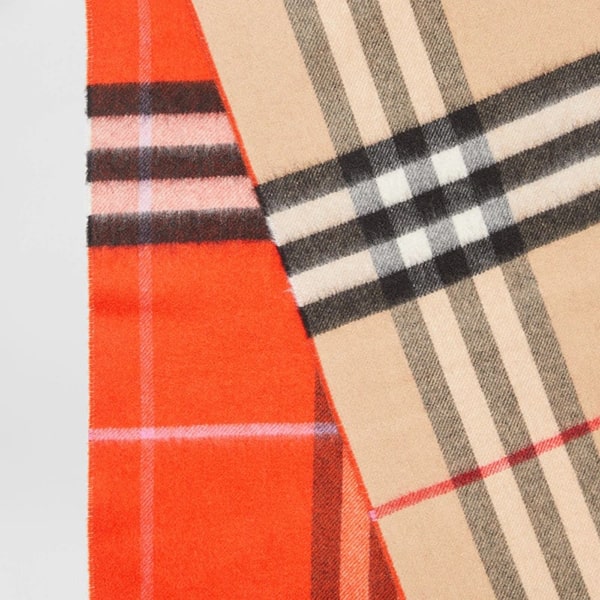
Maintaining the luxurious look and feel of a cashmere scarf involves careful washing, storage, and periodic maintenance. While cashmere is a durable material, it requires gentle handling to preserve its quality.
Hand washing is often recommended, using a mild detergent in lukewarm water. Avoid wringing or twisting the scarf, instead gently squeeze out excess water and lay it flat on a towel to dry, reshaping it as needed. Never expose it to direct heat or sunlight while drying.
Store your cashmere scarf in a cool, dry place, preferably folded on a shelf or in a drawer. Using a breathable bag can protect it from dust and moths. Avoid hanging, as this can cause the scarf to lose its shape.
Over time, cashmere may naturally begin to pill – small balls of fiber appearing on the surface. This can be carefully removed using a cashmere comb or a similar tool designed for this purpose.
If the scarf becomes damaged, it’s advisable to take it to a professional for repair, especially if the damage is significant. Regular inspections for any signs of wear and tear can help keep your cashmere scarf looking its best for years to come.
Buying Cashmere
When investing in a cashmere scarf, several key factors should be considered to ensure you’re purchasing a high-quality product. Firstly, the fineness and length of the cashmere fibers are paramount. Finer, longer fibers result in a softer, more durable scarf. Pay attention to the ply of the scarf; a 2-ply scarf is generally warmer and less prone to holes than a 1-ply one. Also, consider the tightness of the weave or knit; a tighter weave usually indicates higher quality.
The price of cashmere scarves can vary widely, from around $50 to several hundred dollars, depending on factors such as brand reputation, quality of the cashmere, and the complexity of the design. It’s important to set a realistic budget that takes into account the longevity and timeless appeal of high-quality cashmere.
Many brands offer high-quality cashmere scarves. Some top-tier cashmere brands include Loro Piana, Brunello Cucinelli, and Burberry, known for their craftsmanship and use of the finest cashmere.
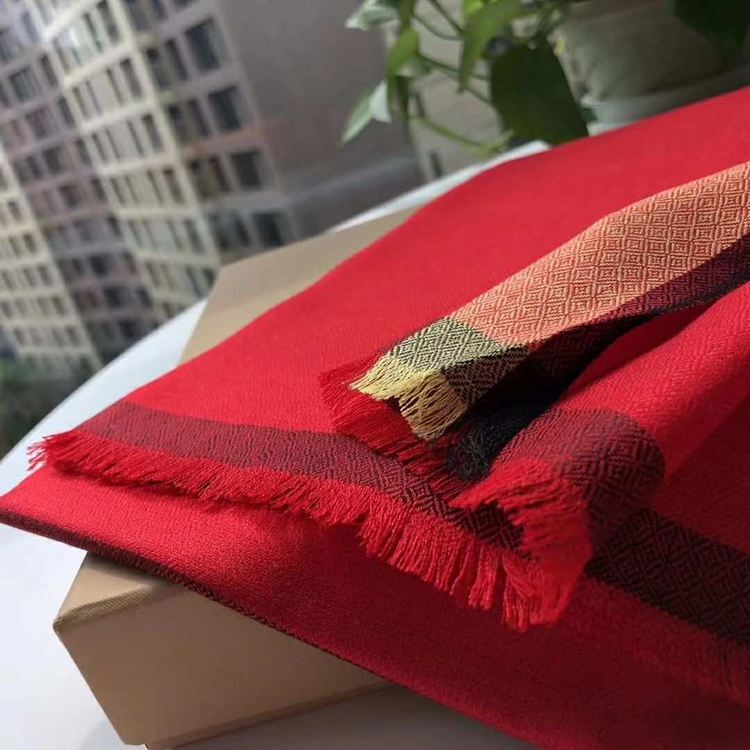
Mid-range brands, like J.Crew and Uniqlo, offer more affordable options. Depending on your location and preference, cashmere scarves can be purchased in-store or online. Online platforms such as the brand’s official website, luxury fashion e-commerce sites, or general platforms like Amazon, offer a wide range of options. Always ensure to purchase from reputable sources to avoid counterfeit products.
Ethical and Sustainable Cashmere
The production of cashmere can have significant environmental impacts. Overgrazing by cashmere goats can lead to land degradation and desertification, especially in regions like Mongolia where cashmere production is a major industry. The increasing demand for cheap cashmere has also resulted in concerns about animal welfare and labor rights.
However, the cashmere industry has seen a shift towards more ethical and sustainable practices. Brands are focusing on traceability, ensuring that the cashmere they source comes from goats that are reared in a sustainable manner with humane treatment. Additionally, efforts are being made to improve the living and working conditions of the herders and workers involved in cashmere production.
Several brands have committed themselves to ethical and sustainable practices in cashmere production. For example, Patagonia uses recycled cashmere and ensures fair trade certification in its supply chain. Likewise, Naadam has established direct relationships with herders, paying them directly and investing in local communities to create a sustainable sourcing setup. Stella McCartney, a luxury brand, is also known for its commitment to sustainability and cruelty-free sourcing.
With consumers becoming increasingly conscious of the environmental and ethical implications of their purchases, opting for sustainable and ethically produced cashmere is a step towards more responsible consumption. The industry’s shift in this direction demonstrates a commitment to balancing luxury and quality with sustainability and ethical practices.
Conclusion
In conclusion, cashmere scarves are a luxurious, versatile, and enduring addition to any wardrobe. They are made from the fine undercoat of cashmere goats and require careful production methods to ensure quality. Both men and women can enjoy various styles, patterns, and colors of cashmere scarves, with different ways to style and pair them with outfits.
In purchasing cashmere scarves, the fineness and length of the fibers, the ply of the scarf, the tightness of the weave, and the brand reputation are important considerations. While high-quality cashmere can be an investment, its longevity and timeless appeal justify the cost. Reputable brands offer a range of options, from luxury to more affordable ranges.
Proper care, through gentle washing, careful storage, and regular maintenance, can help keep a cashmere scarf looking its best for years. Regular inspections and professional repairs can also extend its lifespan.
A growing trend in the industry is the shift towards ethical and sustainable production of cashmere, with a focus on mitigating environmental impact and ensuring fair labor practices. Brands like Patagonia, Naadam, and Stella McCartney are leading the way in this regard. As consumers, considering the ethical and environmental implications of our purchases is an important aspect of responsible consumption.
FAQ
1. What makes cashmere scarves a luxury accessory?
Cashmere scarves are considered a luxury due to the quality of the material. Cashmere comes from the undercoat of cashmere goats, and it’s known for its exceptional softness, warmth, and durability. The process of collecting and refining the wool is labor-intensive, which contributes to the higher cost of cashmere products.
2. How can I distinguish high-quality cashmere?
High-quality cashmere is determined by the length and fineness of the fibers. Longer, finer fibers result in a softer, more durable scarf. Additionally, a 2-ply scarf is typically warmer and less likely to develop holes than a 1-ply one. A tighter weave also indicates higher quality.
3. How should I wash and store my cashmere scarf?
Your cashmere scarf should ideally be hand washed using a mild detergent in lukewarm water. Avoid wringing or twisting the scarf. After washing, gently squeeze out excess water and lay it flat on a towel to dry. For storage, fold your scarf and keep it in a cool, dry place, preferably inside a breathable bag to protect against dust and moths.
4. What’s the price range of cashmere scarves?
The price of cashmere scarves can vary greatly, from around $50 to several hundred dollars. Factors influencing the price include the quality of the cashmere, the reputation of the brand, and the complexity of the design.
5. How can I style a cashmere scarf for different occasions?
For a casual look, pair a brightly colored or patterned scarf with simple attire. For a professional setting, choose a neutral-colored scarf that complements your suit or dress. For an evening out, an elegant cashmere pashmina can add a luxurious touch to your outfit.
6. Which brands are known for their commitment to ethical and sustainable cashmere production?
Brands such as Patagonia, Naadam, and Stella McCartney are known for their commitment to ethical and sustainable cashmere production. They focus on traceability and fair trade practices, ensuring their cashmere is sourced responsibly.
7. What are some common trends in cashmere scarves for men and women?
For women, oversized, infinity, and pashmina cashmere scarves are popular, along with scarves featuring various patterns and colors. For men, traditional, infinity, and oversized scarves are trending. Neutral colors and classic patterns like tartan and herringbone are common in men’s scarves.
